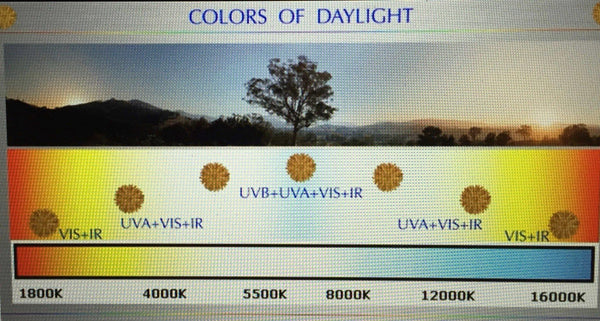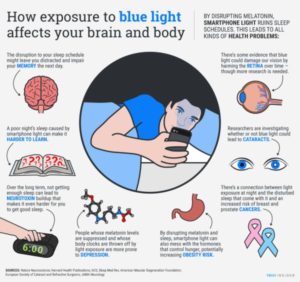
What is so wrong with blue light? Why do people say blue light is bad for us? Where does this blue light come from?
In nature the sun provides a complete spectrum of light frequencies, emitting all the colours of the rainbow including blue light. The big deal with natural sunlight is that the different light frequencies are balanced with each other and not isolated.

Now take your computer screen, that is a very different story. The light being emitted from your screen is very heavy on the blue and the other colour frequencies needed to provide balance are lacking, especially the red. Red light is the major balancer for blue light. You could imagine this like comparing natural sunlight to your phone screen is like comparing a whole natural food with a processed food. Butter or margarine, what would you choose?

Now to delve into the effects of that unopposed blue “junk” light on you and how you feel.
We all have cells called photo-receptors in our body that respond to the environment to signal to our body systems how to behave. One of these light receptors is called melanopsin and is found especially in our eyes, but also in skin, subcutaneous fat cells and even in our blood. Melanopsin is the blue light receptor. Think about that - these parts of our body all have receptors for blue light particularly.

It turns out that during the 24 hour daily cycle that it is the blue frequencies of sunlight that change the most and act as signallers to our body telling it the time of day and so directs how the body systems behave. For instance first thing in the morning before the sun is very high in the sky the sunlight signals tell our body to produce melatonin. You may be thinking that melatonin is the sleep hormone. Well, yes it is, but it turns out that melatonin is made in the morning ready for release later on. When your melanopsin receptors notice that the light is dropping in the evening it prepares you by signalling the release of melatonin ready to help send you off for good night’s sleep.
So, if you are staring in to a screen, be it the computer, TV or your phone you are sending a message to your body that is is midday - whatever time of day or night you are doing this! How do most people spend their evening time? Is it any wonder we have an epidemic of poor sleep, stress and anxiety?

How have we altered our environment?
We have flooded our lives with artificial light at night. Modern LED lights are really heavy on the blue part of the spectrum. They may be saving energy, but they are depleting you of yours.
What can be done about this?
The first thing to do is consider how you can mange the lighting in your home. Old fashioned incandescent light bulbs provide for a much healthier balance of light frequencies, and many people feel it to be a more pleasant lighting experience compared to LEDs. Try having lamps around your home with red or orange bulbs that you can use in the evening to create a relaxing feel that is much more conducive to preparing yourself for a decent night’s sleep.
https://the-real-food-company-ltd.myshopify.com/collections/light-bulbs
The next thing you can do is invest in some quality blue blocking glasses. There are more and more kinds of blue-blockers on the market - but do they really do what is needed to protect your health?
We have tried many makes and tested them to see how effective they are. Many are hardly effective at all and so will not give you the needed protection.
We found the Prisma range of blue blocking glasses from Germany that have been designed by one of the world’s leading light scientists, Dr Alexander Wunsch.The special nature of the Prisma lenses are that they are designed to block the most damaging frequencies in the blue range and also some of the problematic green light, but are also designed to allow through a greater transmission of brightness making it easier to see text on a page etc if you are working between paper and the screen. This is called colour rendition, making the glasses easier to adapt to in you daily study or work.

Prisma make 2 shades of lenses, LiTE and PRO.
LiTE lenses are great for daytime use when you need to spend long hours on your screen or even to reduce the stress from spending time under artificial lighting. People notice reduced eye fatigue, soreness, headaches etc.
The PRO lenses block a larger percentage of the damaging light frequencies and are best worn as the light drops in the evening especially if you are watching TV or browsing on your computer and will help promote great sleep by allowing the natural release of melatonin that would usually be blocked by the brightness of the screens etc.
Check out our range pf blue blocking glasses here:
https://the-real-food-company-ltd.myshopify.com/collections/blue-blocking-glasses


